医学英语术语速记讲义
医学英语术语汇总

医学英语术语汇总
English:
Some common medical terms include hypertension (high blood pressure), arthritis (inflammation of the joints), diabetes (a condition of high blood sugar), bronchitis (inflammation of the bronchial tubes), and anemia (a deficiency of red blood cells). Other terms include myocardial infarction (heart attack), pneumonia (infection of the lungs), gastroenteritis (inflammation of the stomach and intestines), leukemia (cancer of the blood or bone marrow), and meningitis (inflammation of the membranes surrounding the brain and spinal cord).
Chinese:
一些常见的医学术语包括高血压(血压升高)、关节炎(关节炎症)、糖尿病(血糖升高的病症)、支气管炎(支气管炎症)、贫血(红细胞缺乏)。
其他术语包括心肌梗死(心脏病发作)、肺炎(肺部感染)、胃肠炎(胃肠道炎症)、白血病(血液或骨髓癌)和脑膜炎(脑和脊髓周围膜炎症)。
如何快速记忆医学英语口语单词_医学英语单词
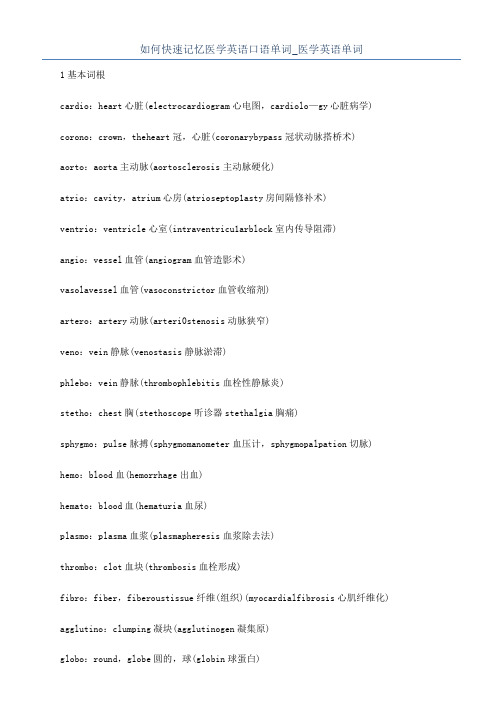
如何快速记忆医学英语口语单词_医学英语单词1基本词根cardio:heart心脏(electrocardiogram心电图,cardiolo—gy心脏病学) corono:crown,theheart冠,心脏(coronarybypass冠状动脉搭桥术) aorto:aorta主动脉(aortosclerosis主动脉硬化)atrio:cavity,atrium心房(atrioseptop1asty房间隔修补术)ventrio:ventricle心室(intraventricu1arblock室内传导阻滞)angio:vessel血管(angiogram血管造影术)vasolavessel血管(vasoconstrictor血管收缩剂)artero:artery动脉(arteri0stenosis动脉狭窄)veno:vein静脉(venostasis静脉淤滞)phlebo:vein静脉(thrombophlebitis血栓性静脉炎)stetho:chest胸(stethoscope听诊器stethalgia胸痛)sphygmo:pulse脉搏(sphygmomanometer血压计,sphygmopalpation切脉) hemo:blood血(hemorrhage出血)hemato:blood血(hematuria血尿)plasmo:plasma血浆(plasmapheresis血浆除去法)thrombo:clot血块(thrombosis血栓形成)fibro:fiber,fiberoustissue纤维(组织)(myocardialfibrosis心肌纤维化) agglutino:clumping凝块(agglutinogen凝集原)globo:round,globe圆的,球(globin球蛋白)sero:serum血清(seroenzyme血清酶)lympho:lymph淋巴(1ymphadenitis淋巴结炎)athero:fattybuildup脂肪堆积(atherosc1erosis动脉粥样硬化)myo:muscle肌肉(cardiomyopathy心肌病;myocardium心肌)cyto:cell细胞(cytotoxic细胞毒的)angino:choking阻塞(anginal心绞痛的)tacho:quick快速(tachycardia心动过速)brachy:short短的(brachycardia心动过缓)2常用后缀加于词根/词干之后,不仅改变其意义,还决定该词的词性,后缀分为简单后缀(如cardiac中的一ac)和复合后缀(如cardiologist中的一logist由log和一ist结合而成).这里主要列出简单后缀中常用的各词性和形容词性后缀,以及与心血管系统有关的复合后缀。
医学英语词汇速查手册

医学英语词汇速查手册在医学领域,掌握英语词汇是非常重要的,无论是进行学术交流还是临床实践,都需要准确理解和运用相关术语。
本速查手册旨在为医学人士提供一个方便快捷的词汇查询工具,涵盖了常见的医学术语,以及与各个医学专业领域相关的词汇。
以下是一些常见的医学英语词汇及其解释:1. Diagnosis (诊断): Determination of the nature and cause of a disease or injury through examination of the symptoms and medical history.2. Treatment (治疗): Medical care provided to a patient for the purpose of improving health or relieving symptoms.3. Surgery (外科手术): Medical procedure performed by a surgeon to treat a disease or injury, involving manual or instrumental techniques.4. Anesthesia (麻醉): Administration of medication to prevent pain and induce a loss of sensation during surgery or other medical procedures.5. Prescription (处方): Written order from a healthcare professional for the use of a specific medication or treatment.6. Patient (患者): Individual who receives medical care or treatment from a healthcare professional.7. Symptom (症状): Subjective indication of a disease or condition experienced by a patient, often reported to a healthcare provider.8. Laboratory (实验室): Facility where medical samples, such as blood or urine, are analyzed for diagnostic purposes.9. Radiology (放射学): Medical specialty that uses imaging techniques, such as X-rays or MRI, to diagnose and treat diseases.10. Disease (疾病): Abnormal condition affecting the body or mind that impairs normal functioning.11. Infection (感染): Invasion and multiplication of harmful microorganisms, such as bacteria or viruses, in the body.12. Allergy (过敏): Abnormal immune response to a harmless substance, resulting in symptoms such as sneezing or rash.13. Immunization (免疫接种): Administration of a vaccine to stimulate the immune system and provide protection against infectious diseases.14. Rehabilitation (康复): Process of restoring function and independence in individuals who have experienced injury or illness.15. Emergency (紧急情况): Medical situation requiring immediate attention and treatment due to a life-threatening condition.本速查手册还包含其他医学专业领域的词汇,例如:1. Cardiology (心脏病学): Branch of medicine that deals with the diagnosis and treatment of heart diseases.2. Gynecology (妇科学): Medical specialty that focuses on the health of the female reproductive system.3. Pediatrics (儿科学): Branch of medicine that deals with the medical care of infants, children, and adolescents.4. Neurology (神经学): Medical specialty that focuses on the diagnosis and treatment of disorders of the nervous system.5. Oncology (肿瘤学): Branch of medicine that deals with the diagnosis and treatment of cancer.以上仅是医学英语词汇速查手册的一小部分内容,此手册将持续更新和扩展,以满足医学领域不断发展的需求。
医学英语术语速记讲义

第一节 医学英语术语 构词规则
下面先举出几个例子,以便取 得一个初步印象。
希腊词素 连合元音 希腊词素 希腊词素 pyel 十 o 十 nephr 十 itis 词根(肾盂) 词根(肾) 词尾(炎) → pyelonephritis 肾盂肾炎
希腊词素 连合元音 希腊词素 连合元音 希腊词素
leuk
医学英语术语速记
How to master medical term rapidly
what
Thrombocyto’penia
Lympho’cytic
Leu’kemia
医学英语术语:上述这些单词来源 于希腊或拉丁词根,有特定的医学 含义,我们将之统称为 -医学英 语术语(medical term); 医学术语学:而将专门研究它的 学问称为-医学术语学(medical terminology):An introduction to the language of veterinary and human medicine
单词重音在倒数第二音节的词尾
-escence(2) adolescence -escent(2) adolescent -ian (2) pediatrician 元音+tion (2) accomodation -ious (2) infectious -ate (2) reticulate -ity (2) disability
而且,随着医学及其边缘科学 的迅猛发展,新的术语仍在与 日俱增。特别是最近几十年来, 每年差不多要出现1000条左右 新术语。因而总的说来,医学 英语术语的条数是一个非常可 观的数量。
除了上述三个原因以外,还有 一个“词条冗长”的问题。固 然有些医学英语术语和普通的 英语单词差不多,仅由几个字 母或十几个字母组成,通过反 复地读和写能够记住它们,但 也有不少的医学英语术语,却 是长长的一大串.
医学英语词根记忆法讲解

Lesson sixbronchus n.[医]支气管-us为名词后缀其复数为把-us变为-I bronchus—bronchicoccus—coccibroncho-【bronchus】bronchoconstriction n.支气管收缩,支气管狭窄bronchogenic adj.支气管原的,产生于支气管的bronchography n支气管造影bronchopneumonia n.[医]支气管肺炎bronchopulmonary adj.[解]支气管肺的bronchorrhagia [医]支气管出血bronchoscope n.[医]气管镜bronchoscopy n.[医]支气管镜检(查) bronchospasm [医]支气管痉挛bronchus n.[医]支气管bronchitis n.[医]支气管炎bronchiole n.[解]细支气管bronchiole细支气管-iole细小arteriole n.细动脉bronchiole n.[解]细支气管foliole n.[植]小叶tonsillitistonsillo-【tonsil扁桃腺】tonsillar扁桃体[腺]的tonsillectomy n.[医]扁桃腺切除术tonsillocentesis扁桃体穿刺术tonsillotomy.[医]扁桃体切开术,扁桃体部分切除术tonsillitisn.[医]扁桃腺炎tonsillectome n.扁桃体切除器-itis炎症alveolitis n.齿槽炎aortitis n.[医]主动脉炎arthritis n.关节炎cephalitis n.[医]脑炎appendicitis n.阑尾炎, 盲肠炎cervicitis n.子宫颈炎colitis n.[医]结肠炎colpitis n.[医]阴道炎cystitis n.[医]膀胱炎dermatitis n.[医] 皮炎microscope n.显微镜micro-表示“极微小, 仪器或工具用以扩大者”之义micro-wave n.微波microbe n.微生物, 细菌microbiology n.微生物学microbody n.[生]微体(细胞)microcephaly n.[医]头小畸型micrococcus n.[微生物]微球菌, 球状细菌microelement n.[化]微量元素micrometer n.微米,百万分之一米(长度单位,符号为μm) micronn.微米micropore n.微孔microscope n.显微镜microsurgery n.〈医〉显微外科cytoplasm ]细胞质cyto-细胞cytobiology细胞生物学cytochemistry n.细胞化学,显微生物化学cytochondria (=cytochondriome)线粒体cytohistology细胞组织学cytopathology细胞病理学cytoplasm n.[生]细胞质cytopoiesis细胞生成cytotoxin n.[生]细胞毒素cytotropic adj.[生]细胞互向性的,向细胞的,亲细胞的cytozoic细胞(内)寄生的-plasm浆,血浆,质bioplasm n.原生质cytoplasm n.[生]细胞质protoplasm n.[生]原生质exoplasm n.外胞浆, 外质nucleoplasm n.核原形质, 核浆karyoplasms n.核质somatoplasm n.体细胞原生质, 体细胞浆proto-表示“第一, 主要, 原”protobiology原生生物学protocalcium原钙,初钙protokaryon 原核protomitosis 原有丝分裂protovirus原始病毒protozoa 原生动物,原虫semiliquid n.半流体semi-semi-permeable adj.半渗透的semiclosure n.半关闭,部分关闭semiconductor n.[物] 半导体semiconscious adj.半意识的semidigested adj.半消化的semifluidn.半流质adj.半流质的semihyaline adj.半透明的semilucent半透明的semitransparent adj.半透明的semilunar adj.半月形的semilunar cartilage半月软骨semilunar valve n.[解]半月瓣semilunar ganglion半月神经节semiparalysis n.[医]半瘫痪chromosome 染色体chromo-表示“颜色”之义chromocyte色素细胞chromomere n.[生物]染色粒, 染色体小粒chromometer 比色计chromomycin 色霉素chromosome n.[生物]染色体-some表示“体”, “染色体”autosome n.正染色体, 常染色体centrosome n.[生物](细胞的)中心体chondriosome n.[生]线粒体chromosome n.[生物]染色体endosome n.内涵体euchromosome n.常染色体heterochromosome n.[医]异染色体isochromosome n.[生](细胞)等臂染色体karyosome n.[生物] 染色质核仁, 核粒liposome n.[生]脂质体lysosome n.[生](细胞中的)溶酶体melanosome n.[生]黑(色)素体mesosome n.[微](中)间体microsome n.[生]微粒体nucleosome n.[生化]核小体oxysome n.(细胞中的)氧化粒phagosome n.[生]吞噬小体吞噬体ribosome n.[生化]核糖体sarcosome n.[生]肌粒(肌细胞线粒体) schistosome n.[动] 血吸虫, 裂体吸虫synaptosome n.[生]突触体mitosis有丝分裂mito-mitochondrion n.[生]线粒体mitogen n.[生]有丝分裂原,促细胞分裂剂,分裂素mitogenesis n.有丝分裂发生mitomalcin丝裂马菌素mitomycin丝裂霉素(一种抗肿瘤抗生素) mitoplast 丝状体mitoribosome 线粒体核蛋白体mitosis n.有丝分裂mitotic adj.有丝分裂的, 间接核分裂的-osisabiosis n.无生命acidosisactinomycosis n.放射菌病alkalosis n.[病理]碱毒症amitosis n.无丝分裂, 直接核分裂amyloidosis n.淀粉样变性病anchylosis n.(=ankylosis)[医]关节僵硬anhidrosis n.[医]汗缺乏, 缺汗症baragnosis n.[医]重觉丧失brucellosis n.普鲁氏菌病calcinosis n.[医](普遍性) 钙质沉着carcinomatosis n.[医]癌扩散cirrhosis n.[医]硬化cyanosiscystinosisn [医]胱氨酸病(一种先天性代谢疾患,其特点为胱氨酸尿以及胱氨酸晶体沉积于机体器官内)dermatophytosis n.(=athlete's foot)[医]脚气, 脚癣diagnosis n.诊断diarthrosis n.[医]动关节diverticulosis n.[医](肠)憩室病ecchymosis 瘀癍enarthrosis n.[解]杵臼关节fibrinosis n.[医]纤维素过多症, 血内纤维蛋白过多症fluorosis n.氟中毒granulomatosis n.[医]肉芽肿病reticulocytosis n.[医] 网状细胞(旧名网织红血球)过多症teratosis怪胎,畸形thrombosis n.血栓症tuberculosis n.肺结核toxicosis n.[医]中毒Lesson sevendioxide二氧化物di-dichlorobutane 二氯丁烷diphosphate n.[化]二磷酸dirhinus (=dirhynus)双鼻(畸形)dioxiden 二氧化物-oxiden.[化]氧化物arsenic trioxide n.[化]砒霜, 三氧化二砷diazoxide n.[药]氯甲苯噻嗪,二氮嗪,降压嗪dioxide n.二氧化物hydroxide n.氢氧化物,羟化物monoxide n.一氧化物pentoxide n.[化]五氧化物peroxide n.[化]过氧化物skeletal .骨骼的, 骸骨的skeleto-skeletogenous adj.成骨骼的,长骨骼的skeleton n.(动物之)骨架, 骨骼skeletonless adj.无骨骼的,无骨架的skeletogeny 骨胳形成[发生]muscular 肌(肉)的musculo-肌(肉)muscularity 发达的肌肉, 强壮musculature n.肌肉组织musculin 肌(球)蛋白musculoskeletal adj.[解]肌(与)骨骼的musculus flexor屈肌Lesson eightthermometer 温度计,体温计thermo-表示“热、热电”之义thermocautery n.[医]热烙术thermochemical 热化学的thermocoagulation n.[医]热凝固术thermodynamic adj.热力学的, 使用热动力的thermolysis [化]热(分)解(作用) thermometer n.温度计, 体温计-meteracidimeter n.酸比重计alcoholometer n.酒精表, 酒精比重计barometer n.气压计cardiometer n.[医]心力测量器,心力计cephalometer n.头部测量器fluorometer n.荧光计oscillometer 示波计[医]动脉搏动描记器manometer n.压力计sphygmomanometer血压计, 血压测量计sphygmo-sphygmocardiograph心动脉搏描记器sphygmogram n.[医]脉搏描记,脉搏曲线sphygmology脉学, 脉搏学sphygmomanometer n.血压计, 血压测量计sphygmometer n.[医]脉搏计血压计sphygmosystole 收缩期脉搏曲线sphygmotonograph血压脉搏描记器sphygmus n.脉搏hypertensionhyper-表示“超级, 超过, 超越,在...之上,高于,过度”之义hyperacid adj.酸过多的, 胃酸过多的hyperactive adj.活动过度的, 极度活跃的,活动亢进的hyperadenosis n.[医]腺增大hyperalgesia n.[医]肾上腺机能亢进hyperadrenalism 痛觉过敏hyperalimentation n.( 尤指对无法通过消化道摄取食物的病人所进行的)静脉输入营养液hypercapnia n.[医]血碳酸过多症hyperchloremia血氯过多, 高氯血hypercholesterolemia n.[医]血胆脂醇过多hypercythemia n.[医]红细胞过多症hyperdontia牙过多hyperfunction n.[医]机能亢进, 官能过度hyperglycemia n.多糖症, 高血糖症hyperirritability n.应激性过度,高度过敏hyperkinesis n.[医]运动机能亢奋, 运动过度, 痉挛hypermetrope n.[医]远视者hypermyotonia肌张力过度hypernatremia [医]血钠过多, 高钠血hyperplasia n.[医]增生, 数量性肥大hyperreflexia [医]反射亢进hypersensitivity n.超敏性hypertension n.高血压, 过度紧张hyperthyroidism n.甲状腺机能亢进hypertrophy n.[医]肥大,过度生长, 过度增大hypo-表示“在...之下,亚,次,次于,不足,从属于”之义hypoacidity n.酸减低, 酸hypoalimentation n.[医]营养不良, 滋养不足,进食不足hypoallergenic adj.[医]低变应原的hypoandrogenism雄激素缺乏hypoazoturia n.[医]尿氮过低, 低氮尿hypocalcemia n.[医]血钙过少,低血钙症hypocapnia (血内)碳酸过少, 低碳酸血(症) hypoglossal n.[解]舌下神经adj.舌下的, 舌下神经的hypokalemia (=hypokaliemia)血钾过少, 低钾血hypolipaemia血脂过少, 低脂血hypomastia n. 乳腺过小hypophysis n.脑下垂体hypoplasia n.[医](器官,组织等)发育不全, [生]细胞减生hypopnea n.[医]呼吸不足,呼吸浅慢hyporeflexia [医]反射减退hyposensitivity n.[医]弱敏, 敏感度减弱hypotension n.血压过低hypothalamus n.[解剖]视丘下部hypothermia n.降低体温-tensionhypertension n.高血压, 过度紧张hypostension 低血压,低血压症状hypotensionn. 血压过低detension n.轻松,松驰intension n.紧张surface tension n.表面张力vapor tensionn.蒸气压, 气压nasogastric adj.[医]鼻饲的naso-鼻子nasopharynx. 鼻咽nasofrontal adj.鼻额的, 鼻额骨的nasogastric adj.[医]鼻饲的nasology n.鼻学nasopalatine canal鼻腭管nasopharyngitis n.[解]鼻咽炎nasoscope n.[医]鼻镜, 电光鼻镜gastro-表示“胃”之义gastroanastomosis胃吻合术gastroenteritis n.[医]肠胃炎gastroduodenal adj.[解]胃与十二指肠的gastroduodenostomy n.[医]胃与十二指肠吻合术gastroenterology n[医]肠胃病学gastrogavage 胃管饲法gastrointestinal adj.[解]胃与肠的gastrologist n.烹饪学者, 胃病学家, 美食家gastroscope【医】胃(窥)镜gastrostomy n.[医]胃造口术endocrine n.内分泌endo- 表示“内部”之义endoangiitis n.[医]血管内膜炎endoarteritis n.[医]动脉内膜炎endocarditis n.[医]心内膜炎endocardium n.[解剖]心内膜endocranium n.[医]硬脑膜,颅内骨膜endocrine n.内分泌endocrinology n.内分泌学endoderm 内胚叶, 内皮层endometritis n.[医]子宫内膜炎endomyocarditis n.[医]心肌膜炎endoscope n.[医]内诊镜,内窥镜,内腔镜-crineapocrine adj.[医]顶(浆分)泌的,泌离的eccrine adj.[生理]分泌腺的,外分泌腺的endocrine n.内分泌exocrine adj.[医]外分泌的heterocrine adj.(腺)多种分泌的holocrine adj.[生理]全泌的, 全浆分泌的hyperthyroidism 甲状腺机能亢进thyroido- thyro-thyroidectomy n.[解]甲状腺切除术thyroiditis n.甲状腺炎thyroidomania甲状腺(机能亢进)性精神病thyroiodine 甲状腺素thyronine 甲腺原氨酸thyropathy 甲状腺病thyroprotein 甲状腺蛋白, 甲状腺球蛋白thyrotoxicosis n.[医]甲状腺毒症, 甲状腺功能亢进thyrotropic adj.[生理]促甲状腺的,调节甲状腺活动的thyrotropin n.[生化]促甲状腺素, 甲状腺刺激激素thyroxin n.[生化]甲状腺素, 甲状腺氨酸antithyroid adj.& n.抗甲腺的(药剂)euthyroid adj.[医]甲状腺机能正常的hyperparathyroidism n.[医]甲状旁腺功能亢进hyperthyroidism n.甲状腺机能亢进hypothyroidism n.[医]甲状腺机能减退tetraiodothyronine n.[生化]甲状腺素, 甲状腺氨酸,四碘甲状腺原氨酸-ismcatabolism n.[生物]异化作用, 分解代谢hyperthyroidism n.甲状腺机能亢进lymphatism n.[医]淋巴体质, 淋巴器毒血症macrodontism n.[医]巨牙metabolism n.新陈代谢, 变形acromegaly n.肢端肥大症acro- or acr- pref.顶部;顶峰.向顶的,高度.起首;开头.肢端肢体的端部.acrobat n.(走钢丝的)杂技演员acroblast 原顶体acrobrachy 肢端过短(症)acrobystia 包皮acrobystiolith包皮结石acrobystitis包皮炎acrocephalia n.(=acrocephaly)尖头的, 尖头畸型的acrocontracture (四)肢挛缩acrocyanosis n.[医]手足发绀acrodermatitis 肢皮炎acrodolichomelia 手足过长acrodynia n.[医]肢端痛acroerythema 肢端红斑acrokeratosis 肢端角化症acromania 重躁狂, 顽固性精神病acromegaly n.肢端肥大症acrometagenesis 四肢发育过度acroneurosis 肢体神经[机能]病,肢体神经官能症acronym n.只取首字母的缩写词acropathy n.[医]四肢病acrophobia n.[医]恐高症-megalyacromegaly n.肢端肥大症cardiomegaly n.[医]心脏扩大症chiromegaly n.[医]巨手畸形hepatomegaly n.[医]肝肿大splenomegaly n.[医]脾(肿)大(亦作splenomegalia)cardiopulmonary n.心肺的cardio-表示“心脏”之义cardioactive adj.(药物等)作用于心脏的cardiocentesis 心脏穿刺术cardiodynia n.[医]心痛, 胸痛cardiogenic adj.[医]心脏性的, 心原性的cardiogram n.心电图cardiology n.[医]心(脏)病学cardiomegaly n.[医]心脏扩大症cardiomyopathy n.[医](尤指原发性的)心肌症cardiorespiratory adj.[医]心和肺的cardiotoxic adj.[医]心脏中毒的cardiovascular adj.心脏血管的cardioversion n.[医]心律转变法,复律法carditis n.心脏炎bradycardia n.[医]心搏徐缓dextrocardia n.(=dexiocardia)[医]右位心pulmono-pulmonary adj.肺部的pulmonate adj.有肺的n.有肺的动物pulmonic adj.肺的, 有肺的, 由肺进行地pulmonis [解]肺尖pulmonitis 肺炎myocardial [解]心肌的myo-myoblastoma成肌细胞瘤myobradia肌反应迟钝myocardium n.[解]心肌( 层)myocellulitis肌蜂窝织炎myoclonia n.[医]肌阵挛(症)myocyte n.[生]肌细胞myodynamics肌动力学(肌肉活动的生理学) myodysplasia 肌发育异常myodystrophy肌营养不良Lesson Tentuberculosis n.结核病tuberculo-表示“结核病,结核性”之义tubercle bacillus n.[医]结核菌tubercular adj.有小突起的, 结节的, 结核的tuberculation n.结节之形成, 结核之形成tuberculin n.结核菌素tuberculoid adj.[解]类似结节的,[医]结核样的tuberculoma n.[医](尤指脑内的)结核瘤tuberculopneumoconiosis 尘肺结核tuberculoprotein 结核菌蛋白tuberculosis n.肺结核tuberculous adj.有结的, 结节状的, 患有结核病的tuberculotoxin 结核菌毒素bronchiectasis n.支气管扩张症-ectasisatelectasis n.[医](出生时肺的)肺膨胀不全bronchiectasis支气管扩张ptyalectasis n.[医]涎管扩张sialectasis n.[医]涎管扩张telangiectasis n.[医]毛细管扩张dyspnea 呼吸困难dys-表示“困难的,有病的”之义dysostosis骨发育障碍, 骨发育不全dysparathyroidism.甲状旁腺机能障碍dyspepsia n.[医]消化不良, 胃弱dysphagia n.[医]吞咽困难,咽下困难dysphasia n.[医]言语障碍症dyspnea n.呼吸困难dyspraxia 运动困难, 运用障碍-pneaapnea n.无呼吸, 呼吸暂停dyspnea n.呼吸困难eupnea n.[医]呼吸正常, 平静呼吸hyperpnea呼吸过度, 喘息hypopnea n.[医]呼吸不足,呼吸浅慢polypnea n.呼吸急促,气促Lesson Elevenatherosclerosis动脉粥样硬化atheroma n.动脉粥样化, 粉瘤atheromasia动脉粥样变性atherosclerosis n.[医]动脉硬化症atheromatosis n.[医]动脉粥样化症-sclerosissclerosis n.[医]硬化症, 硬化, 硬结amyotrophic lateral sclerosis[医]肌萎缩性(脊髓) 侧索硬化arteriosclerosis n.动脉硬化atherosclerosis n.[医]动脉硬化症cardiosclerosis n.[医]心硬化cerebrosclerosis n.[医]脑硬化multiple sclerosis n. 〈医〉多发性硬化myelosclerosis n.[医]脊髓硬化骨髓硬化osteosclerosis n.[医]骨硬化otosclerosis n.[医]耳硬化症phlebosclerosis n.[医]慢性静脉炎,静脉硬化tympanosclerosis n.[医]鼓膜硬化chole- [前缀]表示“胆, 胆汁”之义cholecalciferol〈生化〉胆钙化甾醇,维生素D3cholecyst n.胆囊cholecystalgia 胆囊痛, 胆绞痛cholecystectomy n.[医]胆囊切除术cholecystitis n.[医]胆囊炎cholecystography n.[医]胆囊照相术cholecystokinin n.[生化]缩胆囊素,缩胆囊肽, 肠促胰酶肽choledochitis [医]胆总管炎cholelith n.胆石cholesterol n.胆固醇cholestyramine n.[药]消胆胺(一种阴离子交换树脂,用于治疗胆汁郁滞性瘙痒症)choleuria [医]胆尿症, 胆汁尿-sterol 固醇,甾酮cholesterol n.胆固醇coprosterol n.人粪醇, 粪脂醇dihydrotachysterol n.[化]二氢速留醇ergosterol n.[生化]麦角固醇lumisterol n.[生化]光甾醇tachysterol n.[生化]速甾醇zymosterol n.[生化]酵母甾醇(一种结晶性不饱和固醇) nitroglycerin硝基甘油,硝酸甘油nitro-表示“硝基, 硝石”之义nitroamine 硝胺nitrobenzene n.[化]硝基苯nitrocellulose n.[化]硝化纤维nitrochloroform n.[化] 三氯硝基甲烷nitrogen n.[化]氮nitroglycerin n.[化]硝化甘油nitroguanidine n.[化] 硝基胍nitromannitol n.[化] 硝酸甘露醇酯nitromethane n.[化] 硝基甲烷glycerin 甘油, 丙三醇nitroglycerin n.[化]硝化甘油, 炸药trinitroglycerin n.[化]三硝基甘油Lesson Twelveduodenal十二指肠的duodeno-十二指肠duodenitis n.十二指肠炎duodenotomy 十二指肠切开术duodenum n.十二指肠gastroduodenostomy n.[医]胃与十二指肠吻合术gastroduodenal adj.[解]胃与十二指肠的parasitogenic寄生物所致的,寄生物源的parasito-parasitogenic寄生物原的寄生(物)引起的parasitologist寄生虫病,寄生物学家parasitology n.寄生虫学parasitosis n.[医]寄生物病, 寄生虫病parasitotrope (=parasitotropic)亲寄生虫的-genicacidogenic adj.引起酸化的aerogenic adj.产气的(细菌因新陈代谢产生的气体)的allergenic adj.[医]引起过敏症的biogenic adj.源于生物的, 生物所造成的cardiogenic adj.[医]心脏性的, 心原性的cryptogenic a[医]隐发性的, 病源不明的cytopathogenic adj.[医] 致细胞病变的diabetogenic adj.[医]致糖尿病的embryogenic adj.[生]胚胎发生(形成)的endogenic adj.[地]内成的,内生的,内营力的enteropathogenic adj.致肠病的pathogenic adj.致病的, 病原的, 发病的psychogenic adj.心理性的, 精神性的pyogenic adj.[医]生脓的,化脓的brocellosisbrucella n.[微]布鲁氏菌brucellergen n.[生化]布鲁氏菌抗原(用于皮肤试验, 检查布鲁氏菌感染)brucellosis n.普鲁氏菌病toxic.有毒的,有毒性的,中毒的toxico-toxicoderma中毒性皮病toxicogenic 产生有毒物质的, 有毒物形成的toxicology n.毒物学toxicosis n.[医]中毒toxigenic adj.产生毒素的toxinemia毒血症toxiphobia n.[心]毒物恐怖hepatotropic.亲肝的-tropicadrenocorticotropic adj.[生化]促肾上腺皮质的cytotropic adj.[生]细胞互向性的,向细胞的,亲细胞的lipotropic adj.抗脂肪肝的myotropic adj.[医]影响肌肉的侵袭肌肉的organotropic adj.[生理]亲器官的thermotropic adj.[生]向热的,向温的thyrotropic adj.[生理]促甲状腺的,调节甲状腺活动的hydrotropic adj.[生]向水性的, 向湿性的hypermetropic adj.[医]远视的chloroform氯仿,三氯甲烷chloro-表示“绿”, “氯”chloroamide 氯酰胺chlorocresol 氯化甲酚chloroform n.氯仿vt.用氯仿麻醉chloropromazine n.[药]氯丙嗪, 冬眠硫磷chlorpromazin氯丙嗪,冬眠灵trinitrotoluenen. 三硝基甲苯tri- 表示“三”之义表示“三倍、三次”之义trinitrate 三硝酸酯[盐]trinuclear三环的三核的triacetamide 三乙酰胺triad n.三合体,三价元素triage [医]治疗类选法(根据紧迫性和救活的可能性等在战场上决定那些人优先治疗的方法)triamine (某)三胺tribromide n.[化]三溴化合物collagenosis.胶原性疾病collagen n.胶原质collagenase n.[生化]胶原酶collagenolytic adj.[生化]溶胶原的collagenous adj.成胶的, 产生成胶的dystrophy营养障碍,营养不良-trophyabiotrophy n.[医]营养性衰竭,生活力缺失atrophy n.[医]萎缩, 萎缩症hypertrophy n.[医]肥大,过度生长, 过度增大autotrophy n.[生]自养(作用)cytotrophy n.[生]细胞互向性,向细胞性,亲细胞性eutrophy n.营养正常, 由于矿物质的增加而适合动植物生长leukodystrophy n.[医]脑白质营养不良myoatrophy n.[医]肌萎缩neurotrophy n.神经营养panatrophy n.[医]全身萎缩amyloidosis n.淀粉样变性,类淀粉症amyloamylo-表“淀粉”之义amylase n.[生化]淀粉酶amylogenesis 淀粉形成(作用)amyloidosis n.淀粉样变性病amylolysis n.淀粉分解amylon 淀粉amylose n.直链淀粉, 多糖amylum n.淀粉granuloma n.肉芽肿,肉芽瘤granulo-granulocyte n.[生]粒细胞,粒性白细胞( 细胞质中含有颗粒的一类白细胞)granulocytopenia n.[医]粒细胞减少granulocytosis n.[医]粒细胞增多granulomatosisn.[医]肉芽肿病granulopoiesis 粒细胞生成granulous adj.由小粒而成的, 粒状的-omaembryoma n.[医]胎组织瘤encephaloma n.[医]脑瘤endothelioma n.[医]内皮瘤fibroadenoma n.[医]纤维性瘤fibroma n.纤维瘤glioma n.[医]神经胶质瘤haematoma n.(=hematoma)[医]血肿hepatoma n.[医]肝细胞瘤(尤指恶性肿瘤)leiomyoma n.[医] 平滑肌瘤lipoma n.脂肪瘤lymphoma n.[医]淋巴瘤mastocytoman.[医]肥大细胞瘤melanoblastoma n.[医]成黑素细胞瘤melanoma n.[医](恶性)黑素瘤,(良性)胎记瘤meningioman.[医]脑(脊)膜瘤mesothelioma n.[医]间皮瘤myeloma n.[医]骨髓瘤myoma n.[医]肌瘤myxoma n.[医]粘液瘤neurofibroma n.[医]纤维神经瘤neuroma n.[医]神经瘤osteoma n.[医]骨瘤papilloma n.[医]乳突淋瘤, 刺瘤pheochromocytoma n.[医]嗜铬细胞瘤( 一种交感神经系统的肿瘤) pinealoma n.[医]松果体瘤rhabdomyoma n.[医] 横纹肌瘤scleroman.[医]硬结seminoma n.[医]精原细胞瘤teratoma n.[医]畸胎瘤amebic n.变形虫的ameba n.[动]阿米巴, 变形虫amebacide 杀阿米巴的杀阿米巴药amebiasis n.[医]阿米巴病,变形虫病(尤指原虫寄生肠内引起的阿米巴痢疾)amebocyte n.[医]阿米巴样细胞,变形细胞ameboid adj.似变形虫的radiohepatographyradio-radioactive adj.放射性的, 有辐射能的radioanalysis放射性分析radiobioassay放射生物测定radiochemical adj.[化] 放射化学的n.已含放射性同位素的化学物质radiocytology放射细胞学radioexamination X射线透视法, 伦琴射线透视法radioiodine n.[化] 放射碘radioisotope n.放射性同位元素radiolabel vt.[化]用放射性同位素给…示踪或做标记radiology n.X光线学, 放射线学, 放射医学, X光线科radiophysiology放射生理学-graphy- 构成名词,表示“写、画、记录的用具或方式”angiography n.[医]血管造影术, 血管照相术cardiography n.心动描记法electroencephalography n.[医]脑电图学, 脑电描记法osteography n.[解]骨论salpingography n.[医]输卵管造影术sonography n.[医]超声波检查法, 超声波扫描术sphygmography n.[医]脉搏描记法ultrasonography n.[医]超声波检查法, 超声波扫描术urography n.[医]尿路造影术hypochondriumn.季肋,季肋部chondrio-chondroblast 成软骨细胞chondrocranium n.软骨性颅chondroma n.[医]软骨瘤chondromyoma 软骨肌瘤chondrosarcoma n.[医]软骨肉瘤chondrophyte 软骨赘, 软骨刺chondrosis 软骨形成chondrosteoma软骨骨瘤achondroplasia n.软骨发育不全enchondroma n.[医]内生软骨瘤osteochondrosis n.[医]骨软骨病cholestatic 胆汁郁积的cholestasis [医]胆汁郁积-stasis 壅滞,郁积bacteriostasis n.细菌抑制, 阻止细菌繁殖法cholestasis n.[医]胆汁郁积electrohemostasis n.[医]电止血法fungistasis n.抑真菌作用hemostasis n.(=hemostasia)[医]止血, 止血法homeostasisn.内环境平衡,内环境稳定metastasis n.转移micrometastasis n.(残留癌肿的) 微小转移venostasis n.[医]静脉郁滞hyperbilirubinemian.胆红素血,胆红素血症bili- [拉] 表示“胆汁”, “从胆汁衍生的”biliary adj.胆汁的, 输送胆汁的, 由于胆汁异状的bilien 胆汁烯, 一烯胆色素核biligrafin (=meglumine iodipamide)胆影葡胺bilirubin n.[生化]胆红素biliuria 胆汁尿rubi n.玉红rubiflavin 红玉黄菌素rubigo n.[化] 过氧化铁, 铁丹rubine红宝石rubious adj.红玉色的, 红色的-emia =(-aemia) 表示“血症”anemia n.贫血, 贫血症anoxemia n.[医]缺氧血症, 血缺氧galactosemia n.[医]半乳糖血(症)glycemia n.[医]血糖过多hypercholesterolaemia n.[医]血胆甾醇过多, 高胆甾醇血hypercalcaemia n.[医]血钙过多, 高钙血(症) hyperlipidemia n.[医]血脂过多, 高脂血hypocalcemian.[医]血钙过少,低血钙症hypoxemia n.[医]血氧不足phosphatase n .磷酸酶phospho- 表示“磷的, 含磷的”之义phosphate n.磷酸盐phosphated磷酸盐化的phosphatemia磷酸盐血phosphocreatin n.[生化]磷酸肌酸phosphodiesterase n.[生化]磷酸二酯酶phosphofructokinase n.[生化]磷酸果糖激酶phosphoglycoprotein 磷糖蛋白phosphokinase n.[生化]磷酸激酶phospholipase n.[生化]磷脂酶phosphor n.磷-aseATPase n.[生化]ATP酶,腺苷三磷酸酶D.N.A.ase n.[生化]脱氧核糖核酸酶(亦称DNase) carbohydrase n.[生化]糖酶cellulase n.[生化]木纤维质酵素, 纤维素酶dehydrochlorinase n.[生化]脱氯化氢酶dipeptidase n.[生化]二肽酶esterase n.[生化]酯酶exopeptidase n.[生化]肽链端解酶,外肽酶galactokinase n.[生化]半乳糖激酶glucokinase n.[生化]葡(萄)糖激酶glycosidase n.[生化]糖苷酶guanase n.[生化]鸟嘌呤酶hexokinase n.[生化]己糖激酶hydrolase n.[生化]水解酶hypertensinase n.[生化]血管紧张肽酶lactase n.乳糖分解酵素lactoperoxidase n.[生化]乳过氧(化)物酶lyase n.[生化]裂合酶,裂解酶maltasen.[生化]麦芽糖酶nucleotidase n.[生化]核苷酸酶nucleotidyltransferase n.[生化]核苷酸转移酶oxydase n.[生化]氧化酶phosphatase n.[生化]磷酸(酯)酶phosphokinase n.[生化]磷酸激酶polymerase n.[生化]聚合酶reductase n.[生化]还原酶ribonuclease n.[生化]核糖核酸酶Lesson Thirteenpathological n.病理的,病理性的patho-表示“痛苦, 疾病”之义pathobiology n.病理学pathogenesis n.[医]发病机理pathogens 病原体(物)pathology n.病理学pathophysiology n.[医]病理生理学pathopsychology病理心理学pathotype 病变型cystitis n.膀胱炎cysto-cystocele n.[医]膀胱突出症cystodynia 膀胱痛cystolith [医]膀胱结石cystotomy n.[医]膀胱切开术cystourethritis膀胱尿道炎nephritis n.肾炎nephrism n.[医]肾病性恶病质nephrocyte 肾原细胞nephrodystrophy 肾病, 肾营养不良nephrology n.肾脏学nephroptosis肾下垂nephropyelitis肾盂肾炎nephrostomy n.[医]肾造口术nephrotoxic adj.[医]对肾脏有害处的, 足以危害肾脏的nephrosclerosis 肾硬化, 肾硬变(症) arteriosclerosis n.动脉硬化,血管硬化arteriopathy 动脉病arteriosis动脉病arteriovenostomy 动静脉吻合术arteriovenous adj.动静脉的, 连接动静脉的arteritis n.动脉炎arteriology动脉学arteriole n.细动脉arteriomalacia 动脉软化arteriosympathectomy 动脉交感神经切除术albumin n.白蛋白albuminuria n.[医]蛋白尿albumoscope (尿)白蛋白测定器albuminolysis 白蛋白分解, 蛋白质水解[作用] uremia n.尿毒症urolith 尿(结)石urology n.[医]泌尿学uromelanin 尿黑素urinal n.尿壶, 小便池urinary adj.尿的, 泌尿器的urination n.撒尿urinogenital adj.泌尿生殖器的Lesson FourteenLesson Fifteencerebrovascular脑血管的cerebro-[前缀]表示“脑, 大脑”之义cerebrogalactose脑半乳糖, 脑糖cerebrology脑学cerebroma脑瘤cerebromalacia n.[医]脑软化cerebrospinal adj.脑脊髓的cerebrovascular adj.[医]脑血管的-vascular血管的avascular adj.[解](组织等) 无血管的cardiovascular adj.心脏血管的cerebrovascular adj.[医]脑血管的extravascular adj.血管外的, 没有血管的intravascular n.血管内的microvascular adj.[解]微脉管(直径小于0.3 毫米的微血管)的neurovascular adj.神经与血管的perivascular adj.[解]血管周的renovascular adj.[解][医]肾血管(性)的hemorrhage出血,溢血,出血hemo - or hema- or hem-also haemo- or haema- or haem-血:hemoagglutinin 血红素凝结素hemochromatosis n.[医]血色沉着病hemoconcentration 血浓缩hemodialysis n.[医]血液透析, 血液渗析(去除血液中的污物) hemodynamics n.(=haemodynamics)血液动力学hemodynamometer 血压计hemoglobinuria n.[医]血红素尿, 血色蛋白尿hemoglutinin凝血素hemolysis n.溶血hemometra (=hematometra)子宫积血hemopathology 血液病理学hemophilia n.血友病hemopoietin 促红细胞生成素hemoptysis n.[医]咳血, 咯血hemorrhinia 鼻出血, 衄血hemorrhoids n.痔疮, 痔疾hemotherapeutics n.[医]血疗法-rrhagiamenorrhagia n.[医]月经过多metrorrhagia n.[医]子宫出血pneumorrhagia n.[医]肺出血rhinorrhagia n.[医] 鼻出血aphasia不语,失语-phasiaaphasia n.失语症dysphasia n.[医]言语障碍症endophasia n.[语]内部言语,无声语exophasia n.[语]外部语言,有声的语言jargonaphasia n.[医] 杂乱性失语paraphasia n.[医]语言错乱, 错语症hemiplegia半身不遂,偏瘫-plegiacycloplegia n.[医]睫状肌麻痹diplegia n.双侧瘫痪hemiplegia n.[医]偏瘫, 半身麻痹, 半身不遂laloplegia n.[医]言语器肌麻痹,语器麻痹, 言语机能障碍ophthalmoplegia n.[医]眼肌瘫痪, 眼肌麻痹pamplegia n.[医]全麻痹,全瘫panplegia n.[医]全麻痹,全瘫paraplegia n.[医]截瘫, 下身麻痹quadriplegia n.[医]四肢麻痹,四肢瘫痪tetraplegia n.[医]四肢麻痹,四肢瘫痪Lesson Sixteenstreptococci链球菌strepto-streptococcemia 链球菌菌血症streptococcus n.[微]链球菌streptodornase n.[生化][药]链道酶, 链球菌去氧核糖核酸酶(略作SD)streptokinase n.[生化][药]链激酶,溶栓酶(略作SK)streptolysin n.[生化]链球菌溶血素streptomycin n.链霉素-coccuscryptococcus n.[植]隐球酵母,隐球菌diplococcus n.[生物] 双球菌enterococcus n.[微]肠球菌gonococcus n.淋菌meningococcus n.[微]脑膜炎球菌micrococcus n.[微生物]微球菌, 球状细菌pneumococcus n.[医] 肺炎球菌staphylococcus n.[微生物] 葡萄状球菌streptococcus n.[微]链球菌leukocytosis n.白细胞增多,白血球增多leuko-表示“白血球, 白色的或无色的”之义leukemian. 白血病leukemogen 致白血病物质leukoblastosis 白细胞组织增生leukocyte n.[解]白细胞, 白血球leukocytogenesis 白细胞形成leukonuclein 白细胞核素leukonychia 白甲病leukopenia n.[医]白血球减少症leukorrhagia白带过多leukothrombopenia 白细胞血小板减少leukovirus n.[医]白血病病毒-cytosis 细胞增多agranulocytosis n.粒性白血球缺乏症erythrocytosis n.[医]红血球增多(症)granulocytosis n.[医]粒细胞增多hyperleucocytosis n.[医]白血球过多leucocytosis n.[医]白细胞增多,白血球增多lymphocytosis n.[医]淋巴球增多reticulocytosis n.[医] 网状细胞(旧名网织红血球)过多症thrombocytosis n.[医]血小板增多(症)erythrocyte 红细胞,红血球erythro-红, 赤erythroblast n.[生理]成红血球细胞, 有核红血球erythroblastoma [医]成红细胞瘤erythrocatalysis 红细胞溶解erythroclasis 红细胞破碎erythrocyte n.[医]红血球erythrocytopoiesis 红细胞生成erythrocytosis n.[医]红血球增多(症)erythroleukemia n.[医]红白血病erythrolysis 红细胞溶解erythromycin n.红霉素erythropsia n.[医]红视症, 红视-cyte 表示“细胞”amebocyte n.[医]阿米巴样细胞,变形细胞erythrocyte n.[医]红血球granulocyte n.[生]粒细胞,粒性白细胞( 细胞质中含有颗粒的一类白细胞)hematocyte n.(=haematocyte)血球, 血细胞keratinocyte n.[生化]角化细胞leukocyte n.[解]白细胞, 白血球megakaryocyte n.[生]巨核细胞monocyte n.[生]单核细胞myelocyte n.[生]髓细胞,中幼粒细胞myocyte n.[生]肌细胞neurocyte n.[解]神经细胞normocyte n.正常红血球phagocyte 吞噬细胞arthritis 关节炎arthrocele 关节肿大arthrocentesis关节穿刺术arthrodesis n.[医]关节固定术,人为关节强硬术arthrodynia (=arthralgia)关节痛arthroendoscopy 关节内腔镜检查arthrology n.关节学arthropyosis 关节化脓arthrosis n.关节, 关节病arthrotomy n.[医]关节切开(术)rheumatoid .风湿症的, 患风湿症的rheumato-rheumarthritis[医]风湿性关节炎rheumatalgia 风湿痛rheumatic adj.风湿的rheumaticosis小儿风湿状态rheumatics n. 风湿病rheumatism n.风湿, 风湿病rheumatoid arthritis n.类风湿性关节炎rheumatology n.风湿病学rheumatosis风湿病-oid构成形容词,表示“像…的”构成名词,表示“像…的东西ameboid adj.似变形虫的bacterioid n.(=bacteroid)类似细菌体adj.(=bacteroid)细菌性的, 假细菌的carotinoid [生化]类胡罗卜素chorioid adj.脉络膜的n.脉络膜colloid n.胶体adj.胶体的corticoid n.(=corticosteroid)[生化]肾上腺皮质类脂醇deltoid n.[解] 三角肌dermoid adj.皮样的, 皮状的diphtheroid adj.似白喉的, n.类白喉fibrinoid adj.纤维蛋白样的hydrocephaloid脑积水样的lipoid n.[化]类脂adj.类脂的osteoarthritis n. 骨关节炎osteo- 表示“骨”之义(在元音前作oste-) osteoarthritis n.[医]骨关节炎osteoarthrosis n.[医]骨关节炎osteochondritis n.[医]骨软骨炎osteoclast破骨细胞osteoblast n.造骨细胞osteodystrophia骨营养不良骨发育不全osteoepiphysis骨骺Lesson Seventeen asepsis 无菌,无菌法sepsisn.脓毒病antisepsis n.防腐, 消毒asepsis n.无菌, 防腐处理, 灭菌法antiseptic adj.防腐的, 杀菌的, 消过毒的n.防腐剂, 杀菌剂aseptic n.防腐剂adj.无菌的preantiseptic adj.[医]防腐法采用前的,抗菌法采用前的preaseptic adj.[医]无菌外科以前的septic adj.腐败的, 败血病的, 脓毒性的n.腐烂物septicemia n.败血病septicopyaemia n.<英>[医]脓血症, 毒血症septicopyemia n.<美>=septicopyaemia asepticism n.无菌法, 无菌外科学说asepticize vt.使无菌, 消毒antibiotics n.抗生素bio- 表示“生命, 生物”之义biolipid 生物脂biologic adj.生物的, 生物学的biologist n.生物学家biolysis n.生物分解(作用), 死亡abiogenesis n.自然发生abiosis n.无生命astrobiology n.[生物]天体生物学, 太空生物学aerobiotic adj.好氧生活的decongestant n.[医]解充血药congestion n.拥塞, 充血congestive adj.充血的congest vt.使充满, 使拥塞, [医]使充血vt.充塞, 充血, 拥挤decongestion n.(城市等)拥挤的消除(或缓解) [医]充血的减轻decongestive n.[医]可降低充血的myalgia n.肌痛-algia adenalgia n.[医]腺痛arthralgia n.[医]关节痛cephalalgia n.[医]头痛cranialgia n.[医]头痛enteralgia n.[医]肠痛gastralgia n.[医]胃痛hemialgia n.[医]单侧痛keratalgia n.[医] 角膜疼痛odontalgia n.齿痛, 牙痛otalgia n.[医]耳痛uteralgia n.[医]子宫痛Lesson Eighteen brachial adj.臂的, 臂状的brachio- 表示“臂”之义brachiocephalic artery[解]头臂动脉brachia 臂brachial palsy上肢麻痹, 臂瘫痪brachialgia臂神经痛Brachiopoda [复]n.[动]腕足门neurosurgeon n.神经外科医师neuro- 表示“神经”之义neuritis n.神经炎neurobiology 神经生物学neuroblast n.[生]成神经细胞neurochemistry n.神经化学neurodepressive adj.抑制神经的neurodynia神经痛neuroendocrine 神经内分泌的neurogenesis n.[生]神经发生,神经形成neuroglia n.[解]神经胶(质) neuroglobulin 神经球蛋白neurohypophyseal adj.[解]垂体神经部的neurolemma 神经鞘neurology n.神经学, 神经病学neuroma n.[医]神经瘤neuromata neuroma的复数neuromuscular adj.[解]神经肌肉的neuron n.[解]神经细胞, 神经元neuropathy n.神经病neuroprotein .神经蛋白neurosensory adj.[解]感觉神经的neurotoxin n.[生化]神经毒素neurotrophy n.神经营养neurovascular adj.神经与血管的extradural n.硬膜外的dura- duro (=dura mater)【解】硬脑(脊)膜dura mater 硬脑(脊)膜epidural adj.[解]硬(脑)膜上的, 硬脑膜外的extradural adj.[解]硬(脑)膜外的Lesson Ninteen dyspepsia食积,消化不良apepsia n.不消化bradypepsia n.[医]消化徐缓eupepsia n.消化良好radiotherapy n.放射疗法aerotherapy n.空气疗法alimentotherapy n.食物疗法autotherapy (=self-treatment)自我医疗法bacteriotherapy n.细菌疗法biotherapy n.生物制剂疗法chemoimmunotherapy n.[医]化学免疫疗法chemotherapy n.化学疗法cryotherapy n.冷冻疗法dietotherapy n.[医]食物疗法electro-shock therapy n. 电休克疗法,电休克治疗endocrinotherapy n.[医]内分泌疗法hemotherapy n.(=hemotherapeutics)[医]血疗法hormone replacement therapy n. 激素取代疗法hydropsychotherapy n.[医]水浴心理疗法,精神病水疗法hypnotherapy n.催眠术疗法immunotherapy n.[医]免疫疗法kinesitherapy n.[医] 运动疗法massotherapy n.按摩疗法,推拿疗法musicotherapy n.音乐疗法occupational therapy n.职业治疗法organotherapy n.[医]器官疗法somatotherapy n.躯体性疗法(使用药物或手术等生理手段以调节行为的心理疗法) stomatitis n.口炎,口腔炎stomato- stomatoblast 成口道细胞stomatolalia 鼻塞语音stomatology n.[医]口腔病学stomatoscope [医]口腔镜stomatosis (=stomatopathy)口(腔)病Lesson twentyappendectomy n.阑尾切除术appendico- appendo-appendiceal adj.[解]阑尾的appendicectomy n.[医]阑尾切除(术)appendectomy n.阑尾切除术appendices [appendix的复数, 见appendix]appendix n.附录, 附属品, [解]阑尾appendicitis n.阑尾炎, 盲肠炎-ectomyadenectomy n.腺切除术arthrectomy n.关节切除术, 关节截除术cholecystectomy n.[医]胆囊切除术colectomy n.[医]结肠切除术duodenectomy n.[医]十二指肠切除术endarterectomy n.[医]动脉内膜切除术ganglionectomy n.[医]神经节截除术gastrectomy n.[医]胃切除术hemorrhoidectomy n.[医]痔切除术hysterectomy n.[外科]子宫切除(术)iridectomy n.[医]虹膜切除术isthmectomy n.[医]峡部切除术甲状腺切除术labyrinthectomy n.[医]迷路切除术laminectomy n.[医] 椎板切除术laryngectomy n.[医] 喉头切除术lumpectomy n. 〈医〉乳房肿瘤切除术heterograft异种移植异种移植物heterohemagglutinin异种血凝素heterohemolysin 异种溶血素heteroimmunization异种免疫(作用)。
医学英语词汇的速记技巧

医学英语词汇的速记技巧—构词法1 转化法英语中有些单词不须改变词的外形就能由一种词类转化成另一种词类。
单词转化后的意义往往与未转化前的意义有密切的联系。
医学英语中名词与动词的转化较为常见。
动词转化成名词例如: to discharge pus (流脓), nasal discharge (流鼻涕) 等。
例句:He coughs badly. He has a bad cough (他咳得很厉害)。
名词转化成动词例如: three -edged needle (三棱针), to needle a blister (刺破水泡) 等。
例句: The doctor advised the patient to take an X - ray examination (医生建议病人进行X 光检查)。
She should be X-rayed (她必须做X 光检查)。
形容词转化成动词例如: a better condition (较好的条件), to better the condition of the hospital(改善医院的条件) 等。
例句:We must keep the ward clean (我们必须保持病房的干净)。
We clean the ward every day ( 我们每天打扫病房)派生法:在词根的前面加上前缀或者在后面加上后缀构成一个新词, 这种构词方法被称为派生法。
这里我们首先要掌握医学词汇的四种基本成份, 又称为词素(word elements).词根(word root)词根又称词基(word base) 或词干(word stem )。
它是任何一个单词的核心部分, 它包含着这个单词的基本意义。
医学词汇的词根通常来自希腊语或拉丁语, 代表身体的一个部分。
所有的医学词汇有一个或更多的词根。
如gastr (胃), nephr (肾) , cardi(心) 等。
在单词gastroenteritis (胃肠炎) 中gastr 和enter 两个词素是词根。
《医学英语术语速记》课件

The Characteristics of Medical English Terminology
01
Accuracy
Medical terminology must accurately describe diseases,
symptoms, treatment methods, and human body structure
Detailed description
In medical English terminology, many words have the same root, and by mastering these roots, one can quickly understand and learn new words. For
without ambiguity or misunderstanding.
02
Specialization
Medical terminology has a high degree of specialization, and
only trained doctors and medical students can understand and
apply these terms.
03
Internationality
Medical terminology typically uses Latin and Greek, which are
widely accepted and used internationally, making medical
Peer review and citation
The use of standardized medical English terminology aids in the peer review process and facilities accurate citation of relevant research, promoting evidence based medicine
医学英语词汇速查手册

医学英语词汇速查手册作为医学领域从事研究、实践和教学的专业人士,对医学英语的词汇掌握至关重要。
本手册旨在为医学从业者提供一个简洁明了的医学英语词汇速查工具,助您更加高效地理解、沟通和应用医学知识。
一、医学基础词汇1. Symptoms - 症状- Fever - 发烧- Cough - 咳嗽- Headache - 头痛- Fatigue - 疲劳- Nausea - 恶心- Vomiting - 呕吐- Diarrhea - 腹泻- Dizziness - 头晕- Pain - 疼痛2. Body Parts - 身体部位- Head - 头部- Neck - 颈部- Shoulder - 肩膀- Arm - 手臂- Hand - 手- Chest - 胸部- Back - 背部- Abdomen - 腹部- Leg - 腿- Foot - 脚3. Medical Conditions - 医学状况- Diabetes - 糖尿病- Hypertension - 高血压- Asthma - 哮喘- Arthritis - 关节炎- Allergy - 过敏- Cancer - 癌症- Infection - 感染- Stroke - 中风- Heart attack - 心脏病发作- Depression - 抑郁症二、常用医学术语1. Procedures - 手术- Surgery - 外科手术- Biopsy - 活体组织检查- Endoscopy - 内窥镜检查- Radiography - X射线检查- MRI (Magnetic Resonance Imaging) - 核磁共振成像- CT (Computed Tomography) scan - 电脑断层扫描2. Medications - 药物- Antibiotics - 抗生素- Analgesics - 镇痛药- Antidepressants - 抗抑郁药- Antihistamines - 抗组胺药- Anticoagulants - 抗凝药物- Diuretics - 利尿剂- Antipyretics - 退烧药- Sedatives - 镇静剂- Beta-blockers - 贝塔受体阻滞剂- Antacids - 抗酸药三、常见病症/疾病1. Respiratory System - 呼吸系统- Pneumonia - 肺炎- Tuberculosis - 结核病- Asthma - 哮喘- Chronic bronchitis - 慢性支气管炎- Emphysema - 肺气肿2. Cardiovascular System - 心血管系统- Hypertension - 高血压- Coronary artery disease - 冠状动脉疾病- Heart failure - 心力衰竭- Arrhythmia - 心律不齐- Myocardial infarction - 心肌梗死3. Digestive System - 消化系统- Gastritis - 胃炎- Gastroenteritis - 肠胃炎- Peptic ulcer - 消化性溃疡- Hepatitis - 肝炎- Gallstones - 胆石症四、常见医学英语缩写1. CPR - Cardiopulmonary resuscitation - 心肺复苏术2. ICU - Intensive care unit - 重症监护室3. MRI - Magnetic Resonance Imaging - 核磁共振成像4. CT - Computed Tomography - 电脑断层扫描5. EKG/ECG - Electrocardiogram - 心电图6. TB - Tuberculosis - 结核病7. AIDS - Acquired Immunodeficiency Syndrome - 艾滋病8. ADHD - Attention Deficit Hyperactivity Disorder - 注意力缺陷多动症9. OCD - Obsessive-compulsive disorder - 强迫症10. PT - Physical therapy - 物理治疗五、常见医学英语短语1. Take a deep breath - 深呼吸2. Apply pressure - 施加压力3. Stay hydrated - 保持水分摄入4. Get plenty of rest - 多休息5. Follow up with your doctor - 跟进医生建议6. Take the prescribed medication - 按医嘱服药7. Watch your diet - 控制饮食8. Stay active - 保持活动9. Keep the wound clean - 保持伤口清洁10. Avoid smoking and alcohol - 避免吸烟和饮酒六、结语本手册仅在医学英语词汇方面提供了一些基本内容,对于医学从业者而言,持续学习和掌握更丰富的医学英语词汇将助您在日常工作中更加自信和专业。
卫生类职称英语词汇速记(一)
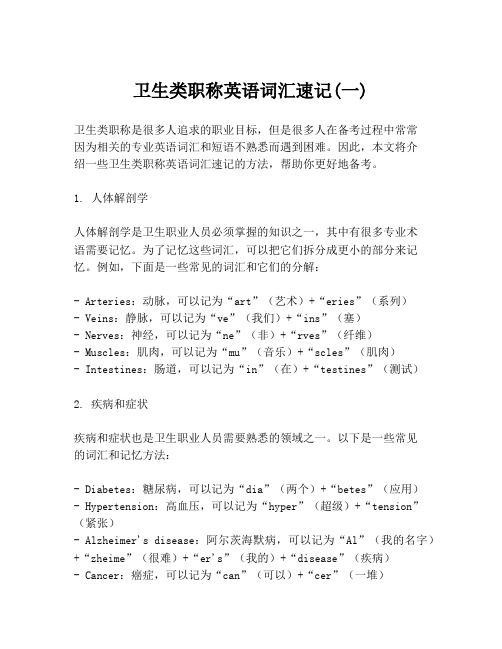
卫生类职称英语词汇速记(一)卫生类职称是很多人追求的职业目标,但是很多人在备考过程中常常因为相关的专业英语词汇和短语不熟悉而遇到困难。
因此,本文将介绍一些卫生类职称英语词汇速记的方法,帮助你更好地备考。
1. 人体解剖学人体解剖学是卫生职业人员必须掌握的知识之一,其中有很多专业术语需要记忆。
为了记忆这些词汇,可以把它们拆分成更小的部分来记忆。
例如,下面是一些常见的词汇和它们的分解:- Arteries:动脉,可以记为“art”(艺术)+“eries”(系列)- Veins:静脉,可以记为“ve”(我们)+“ins”(塞)- Nerves:神经,可以记为“ne”(非)+“rves”(纤维)- Muscles:肌肉,可以记为“mu”(音乐)+“scles”(肌肉)- Intestines:肠道,可以记为“in”(在)+“testines”(测试)2. 疾病和症状疾病和症状也是卫生职业人员需要熟悉的领域之一。
以下是一些常见的词汇和记忆方法:- Diabetes:糖尿病,可以记为“dia”(两个)+“betes”(应用)- Hypertension:高血压,可以记为“hyper”(超级)+“tension”(紧张)- Alzheimer's disease:阿尔茨海默病,可以记为“Al”(我的名字)+“zheime”(很难)+“er's”(我的)+“disease”(疾病)- Cancer:癌症,可以记为“can”(可以)+“cer”(一堆)- Asthma:哮喘,可以记为“asth”(离开)+“ma”(妈妈)3. 医学工具医学工具也是卫生职业人员必须掌握的一部分。
以下是一些常见的工具及其记忆方法:- Stethoscope:听诊器,可以记为“stetho”(胸)+“scope”(范围)- X-ray machine:X光机,可以记为“X”(未知的东西)+“ray”(光线)- Sphygmomanometer:血压计,可以记为“sphygmo”(脉搏)+“mano”(手)+“meter”(计量器)- Scalpel:手术刀,可以记为“scal”(刻)+“pel”(皮)- Forceps:镊子,可以记为“forc”(力量)+“eps”(电子产品)综上所述,通过将专业术语拆分成小部分并将其与相关的词汇或概念联系起来,可以更容易地记忆卫生类职称英语词汇。
医学英语词汇手册

医学英语词汇手册医学英语词汇手册医学领域的专业术语对于医学学习者来说是至关重要的。
为了帮助广大医学学习者更好地掌握医学英语词汇,本手册提供了一些常用词汇的解释和用法示例。
以下是一些常见的医学英语词汇及其解释:1. diagnosis (n. 诊断)- 判断和确认疾病或条件的过程,通常由医生进行。
例如:The doctor made a diagnosis of pneumonia.2. treatment (n. 治疗)- 对疾病或伤害的医学护理。
例如:Chemotherapy is a common treatment for cancer.3. symptom (n. 症状)- 疾病或疾病存在的特定表现或感觉。
例如:One of the symptoms of the flu is a high fever.4. prescription (n. 处方)- 医生向患者推荐的药物治疗方案。
例如:I need to pick up my prescription at the pharmacy.5. surgery (n. 手术)- 医生通过手术操作来治疗或修复身体的过程。
例如:He underwent surgery to remove his appendix.6. anesthesia (n. 麻醉)- 在手术或疼痛治疗中使用药物使患者无痛觉的过程。
例如:The patient was put under anesthesia before the surgery.7. infection (n. 感染)- 疾病或损伤引起的病原体进入体内并繁殖的状态。
例如:He developed an infection after the surgery.8. vaccination (n. 疫苗接种)- 把疫苗引入体内以防止某种疾病的程序。
例如:Children should receive their vaccinations at a young age.9. medical history (n. 病史)- 个体的过去疾病和治疗的详细记录。
医学英语词汇速记——形容词后缀
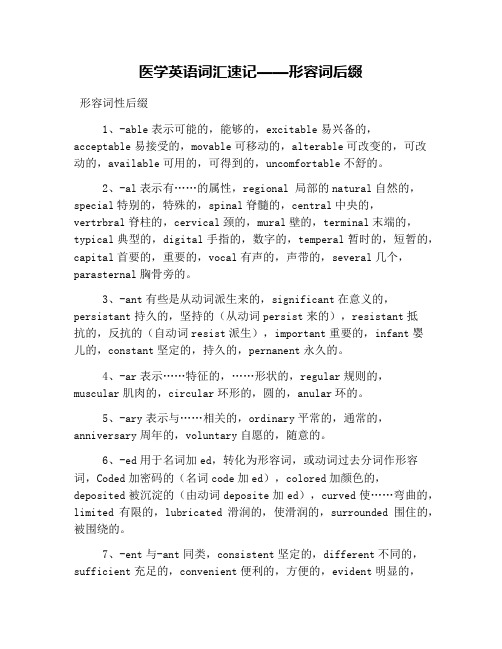
医学英语词汇速记——形容词后缀形容词性后缀1、-able表示可能的,能够的,excitable易兴备的,acceptable易接受的,movable可移动的,alterable可改变的,可改动的,available可用的,可得到的,uncomfortable不舒的。
2、-al表示有……的属性,regional 局部的natural自然的,special特别的,特殊的,spinal脊髓的,central中央的,vertrbral脊柱的,cervical颈的,mural壁的,terminal末端的,typical典型的,digital手指的,数字的,temperal暂时的,短暂的,capital首要的,重要的,vocal有声的,声带的,several几个,parasternal胸骨旁的。
3、-ant有些是从动词派生来的,significant在意义的,persistant持久的,坚持的(从动词persist来的),resistant抵抗的,反抗的(自动词resist派生),important重要的,infant婴儿的,constant坚定的,持久的,pernanent永久的。
4、-ar表示……特征的,……形状的,regular规则的,muscular肌肉的,circular环形的,圆的,anular环的。
5、-ary表示与……相关的,ordinary平常的,通常的,anniversary周年的,voluntary自愿的,随意的。
6、-ed用于名词加ed,转化为形容词,或动词过去分词作形容词,Coded加密码的(名词code加ed),colored加颜色的,deposited被沉淀的(由动词deposite加ed),curved使……弯曲的,limited有限的,lubricated滑润的,使滑润的,surrounded围住的,被围绕的。
7、-ent与-ant同类,consistent坚定的,different不同的,sufficient充足的,convenient便利的,方便的,evident明显的,fluent流利的,流畅的,efficient有效的,frequent常常的,频繁的。
医学英语词汇记忆法(第二版)电子版

医学英语词汇记忆法(第二版)电子版医学词汇的构词概说要顺利阅读医学书刊,就必须掌握大量的医学术语。
英语中的医学术语是由一些基本成分构成的, 这些基本成分主要源于希腊和拉丁语。
现今拉丁语虽然已成为死语,但它对从事人类知识的各领域的专家们来说,确是不可缺少的构词成分。
古罗马人极为擅长医术,当时能说希腊和拉丁两种语言的人相继出现,这就成为医学用语比其他自然科学领域之用语更富于希腊、拉丁构词成分的主要原因。
现今拉丁文字母已成为各国通用的科学符号,不仅在医学领域中应用极为广泛,而且在国际上也起着统一医学术语的作用。
目前已有60多个国家采用拉丁字母作为本国的文字基础,除欧洲少数斯拉夫民族还保留一部分希腊字母外,欧洲、美洲和部分亚洲国家,也都使用拉丁字母。
我国拼音新文字也采用了拉丁字母。
今天,我们学习医学术语的构词成分, 掌握一定数量的词素,将有助于识别词类、了解词义,扩大医学术语的词汇量。
英语医学词汇吸收了大量的拉丁语和希腊语的构词成分。
同一个概念,因词的来源不同,可以由几个词来表达。
所以我们必须重视拉丁语和希腊语的构词成分的学习。
牢记构词成分是掌握医学术语的关键。
国外有些学者认为,如能记忆大约200个构词形及前缀与100 个后缀,不依靠医学词典, 即可理解一般医学术语。
这种见解是有一定根据的。
除了学习医学术语的构词成分之外,在记忆过程中还要注意五到: 心到、眼到、口到、耳到、手到。
即心到要专一;眼到要看清;口到要念准;耳到要听懂;手到要写熟。
第一讲医学词汇的基本成分(Basic Elements of Medical Words)大多数医学词汇由下列成分组成:1) 词根 (Base; Root)2) 前缀 (Prefix)3) 后缀 (Suffix)4) 连接元音 (Combining Vowel)5) 构词结合形式 (Combining Form), 简称: 构词形6) 连字符 (hyphen)1.词根是除去词的附加部分后留下来的部分。
医学英语术语速记讲义95页PPT
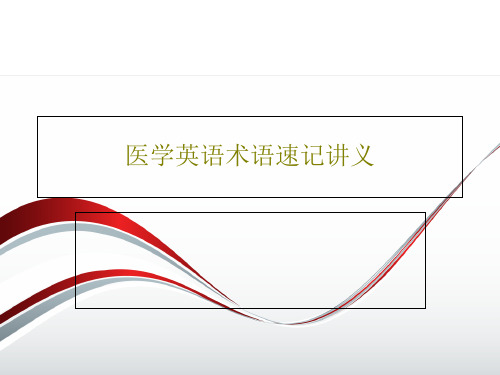
60、生活的道路一旦选定,就要勇敢地 走到底 ,决不 回头。 ——左
医学英语语速记讲义
51、山气日夕佳,飞鸟相与还。 52、木欣欣以向荣,泉涓涓而始流。
53、富贵非吾愿,帝乡不可期。 54、雄发指危冠,猛气冲长缨。 55、土地平旷,屋舍俨然,有良田美 池桑竹 之属, 阡陌交 通,鸡 犬相闻 。
56、书不仅是生活,而且是现在、过 去和未 来文化 生活的 源泉。 ——库 法耶夫 57、生命不可能有两次,但许多人连一 次也不 善于度 过。— —吕凯 特 58、问渠哪得清如许,为有源头活水来 。—— 朱熹 59、我的努力求学没有得到别的好处, 只不过 是愈来 愈发觉 自己的 无知。 ——笛 卡儿
常用医学英语词汇速记手册 背单词
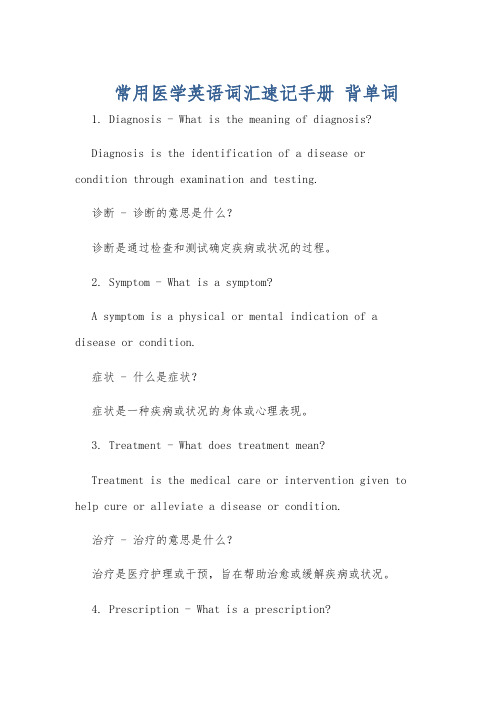
常用医学英语词汇速记手册背单词1. Diagnosis - What is the meaning of diagnosis?Diagnosis is the identification of a disease or condition through examination and testing.诊断 - 诊断的意思是什么?诊断是通过检查和测试确定疾病或状况的过程。
2. Symptom - What is a symptom?A symptom is a physical or mental indication of a disease or condition.症状 - 什么是症状?症状是一种疾病或状况的身体或心理表现。
3. Treatment - What does treatment mean?Treatment is the medical care or intervention given to help cure or alleviate a disease or condition.治疗 - 治疗的意思是什么?治疗是医疗护理或干预,旨在帮助治愈或缓解疾病或状况。
4. Prescription - What is a prescription?A prescription is a written order from a doctor for a specific medication or treatment.处方 - 什么是处方?处方是医生为特定药物或治疗撰写的书面命令。
5. Medication - What is medication?Medication is a substance or drug used to treat or prevent a disease or condition.药物 - 什么是药物?药物是用于治疗或预防疾病或状况的物质或药物。
医学英语词汇的词根记忆法
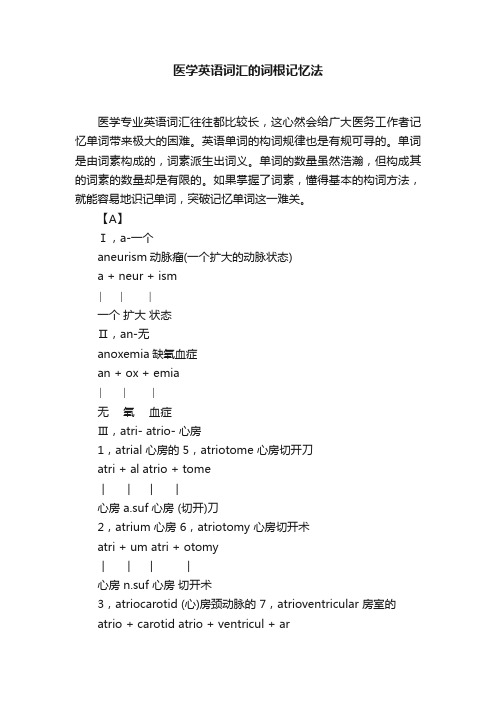
医学英语词汇的词根记忆法医学专业英语词汇往往都比较长,这心然会给广大医务工作者记忆单词带来极大的困难。
英语单词的构词规律也是有规可寻的。
单词是由词素构成的,词素派生出词义。
单词的数量虽然浩瀚,但构成其的词素的数量却是有限的。
如果掌握了词素,懂得基本的构词方法,就能容易地识记单词,突破记忆单词这一难关。
【A】Ⅰ,a-一个aneurism动脉瘤(一个扩大的动脉状态)a + neur + ism∣ ∣∣一个扩大状态Ⅱ,an-无anoxemia缺氧血症an + ox + emia∣ ∣∣无氧血症Ⅲ,atri- atrio- 心房1,atrial 心房的 5,atriotome 心房切开刀atri + al atrio + tome︱︱︱︱心房 a.suf 心房 (切开)刀2,atrium 心房 6,atriotomy 心房切开术atri + um atri + otomy︱︱︱︱心房 n.suf 心房切开术3,atriocarotid (心)房颈动脉的 7,atrioventricular 房室的atrio + carotid atrio + ventricul + ar︱︱︱︱︱心房颈动脉的心房室 a.suf(与…有关的) 4,atrioseptopecy 房间隔修补术atrio + septo + pexy︱︱︱心房间隔修补术Ⅳ,arter-,arteri-,arteria-,arterio-动脉1,artery动脉arte + ry︱︱动脉 n.suf(名词后缀)(arter-中的r被去掉了)2,arterial动脉的arteri + al︱︱动脉 a.suf(…的)(形容词后缀)3,arteriarctia 动脉缩窄arteri + arct + ia︱︱︱动脉缩窄病4,arteriectasia 动脉扩张arteri + ectas + ia︱︱︱动脉扩张病5,arteriectomy 动脉切除术arteri + ectomy︱︱动脉切除术7,angiochondroma血管软骨瘤angio+chondr+oma︱︱︱血管软骨瘤(angei-中的i被去掉了)8,angiodermatitis皮血管炎angio+dermat+itis︱︱︱血管皮炎9,angiolipoma血管脂肪瘤angio+lip+oma︱︱︱血管脂肪瘤(angi-不的I被去掉了)10,angioneuromyoma血管神经肌瘤angio+neuro+my+oma︱︱︱︱血管神经肌瘤11,angioparalysis血管麻痹病angio+paraly+sis︱︱︱血管麻痹病Ⅴ,asthma-气喘1,asthma气喘2,asthmatic气喘的asthmat+ic︱︱气喘a.suf(…的)Ⅵ,ather-athero-粥样的1,atheroma 粥样(粉)瘤ather + oma︱︱粥样(粉)瘤2,atherogenesis 粥样硬化形成athero + gene + sis︱︱︱粥样产生病(指硬化)3,atherogenic 致粥样硬化的athero + gen + ic︱︱︱粥样致a.suf(…的)4,atheromatosis 粥样硬化病athero+matosis︱︱粥样病5,atheronecrosis 粥样坏死athero+necro+sis︱︱︱粥样坏死病6,atherosclerosis 动脉粥样硬化athero + sclero + sis︱︱︱粥样硬化病7,atherosis 粥样硬化athero + sis︱︱粥样病Ⅶ,angei-,angi-,angio- 血管1,angeitis脉管炎 7,angiochondroma血管软骨瘤angei + itis angio+chondr+oma∣ ∣︱︱︱血管炎血管软骨瘤(angei-中的i被去掉了)2,angiectasis血管扩张 8,angiodermatitis皮血管炎angi + ectasis angio+dermat+itis∣ ∣︱︱︱血管扩张血管皮炎3,angitis脉管炎 9,angiolipoma血管脂肪瘤ang + itis angio+lip+oma∣ ∣ ︱︱︱脉管炎血管脂肪瘤(angi-不的I被去掉了)4,angioblast成血管细胞 10,angioneuromyoma血管神经肌瘤angio + blast angio+neuro+my+oma∣ ∣︱︱︱︱血管成…细胞血管神经肌瘤5,angiocardiography心血管造影术11,angioparalysis血管麻痹病angi + cardio + graphy angio+paraly+sis∣ ∣ ∣ ︱︱︱血管心脏照相术血管麻痹病6,angiocardiopathy心血管病angio+cardio+pathy︱︱︱血管心病【B】Ⅰ,bi-1,bicuspid 二尖瓣,二尖瓣的 2,bigemina 二联脉bi+cuspid bi + gemin + a︱︱︱︱︱二尖(瓣) 二成对 n.sufⅡ,brady- 徐缓、迟缓1,bradycardia 心动过缓 3,bradydiastole 心舒张期延长brady + cardia brady+diastole︱︱︱︱过缓心(动) 延长舒张期2,bradycrotic 脉搏徐缓的brady+crotic︱︱徐缓脉搏的【C】Ⅰ,capil-, capillar-, capillar-, capillari-, capillaro- 毛细(血管) 1,capillary 毛细血管的 5,capillariomotor 毛细血管运动capill + ary capillario+motor︱︱︱︱毛细血管 a.suf(与…有关的) 毛细血管运动2,capillarectasis 毛细血管扩张 6,capillarioscopy 毛细显微镜检capillar + ectasis capillario+scopy︱︱︱︱毛细血管扩张毛细镜检查3,capillaritis 毛细管炎 7,capillaropathy 毛细管病capillar+itis capillaro+pathy︱︱︱︱毛细炎毛细管病4,capillarity 毛细现象或作用capillari + ty︱︱毛细 n.suf(表特性)Ⅱ,cardia-, cardio- 心1,cardiac 心的 7,cardiant 心兴奋剂cardi + ac cardi + ant︱︱︱︱心a.suf( …的) 心药剂(医学上)(cardia-中的a被省略)2,cardialgia 心痛,胃灼痛 8,cardiasthma 心性喘息cardi + algia cardi + asthma︱︱︱︱心,胃痛心喘息3,cardiamorphia 心畸形 9,cardiovascular 心血管的cardia + morphia cardio + vascul + ar︱︱︱︱︱心形态病心血管 a.suf4,carditis 心炎 10,cardiophonography 心音图card + it is cardio+phono+graphy︱︱︱︱︱心炎心血管 a.suf5,cardiogenic 心原性的 11,cardiopulmonary 心肺的cardio + gen + ic cardio+pulmon+ary︱︱︱︱︱︱心原 a.suf心肺 a.suf6,cardiomegaly 心肥大cardio+megaly︱︱心肥大Ⅲ,catherter 导管catheterization 导管插入catheter+iz+ation︱︱︱导管化 n.sufⅣ,circula- 循环circulation 循环circula + tion︱︱循环 n.suf(表抽象含义)Ⅴ,coron- 冠状coronary 冠状的coron + ary︱︱冠状 a.sufⅥ,cyan-, cyano-, cyanot-, 青紫、绀、蓝、氰1, cyanamide氰酰胺 3, cyanotic青紫的,紫绀的cyan + amide cyanot + ic∣ ∣ ∣∣氰酰胺青紫a.suf(…的,属…的)2, cyanosis紫绀cyano + sis∣ ∣绀病态。
医学英语快速记忆说课材料

医学英语快速记忆医学英语快速记忆-后缀后缀在缀合法中只起改变词性的作用,不改变词根的含意,这在第一章内已叙述。
现将常用后缀分一般英语后缀及医学英语后缀两部分来说明。
因词性不同、后缀可分为名词性、形容词等。
一、名词性后缀1、-age为抽象名词后缀,表示行为,状态和全体总称,percentage百分数,百分率,voltage电压,伏特数,lavage灌洗,洗,出法,gavage管词法,curettage刮除法,shortage不足,缺少。
2、-cy表示抽象名词,accuracy准确,精确度,infancy婴儿期。
3、-ence、-ance表示性质和动作,difference不同,interference干扰,干预,influence 影响,感化,occurrence发出,出现,violence激烈,暴力,existence存在,significance意义,意味。
4、-ency、-ancy抽象名词后缀,difficiency不足,不全,tendency趋势,趋向,frequency频率,pregnancy妊娠,emergency紧急,急救,fluency流利,流畅,sufficiency 足够,充足,constancy坚定,经久不变。
5、-er表示……人、……者,diameter直径,receiver接收者,接受者,carrier携带者,beginner初学者,创始人,reader读者,shutter 快门,goiter甲状腺肿。
6、-ics 表示……科学,psdiatrics儿科学,psychiatrics精神病学,obstetrics产科学,orthopdics矫形科学,auristrics耳科学,gnathostomatics口腔生理学,andriatrics男性医学,男性科。
7、-ian表示人称名词,physician医师,内科医师,technician技术员。
8、-ication由动词变化而来的抽象名词,常译为……化,simpliffcation简化,calcification钙化,classification分类,分级,communication交流,交往。
